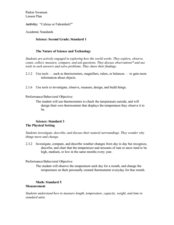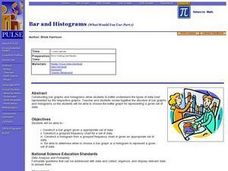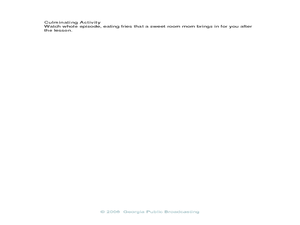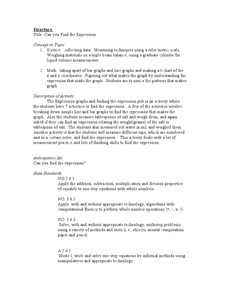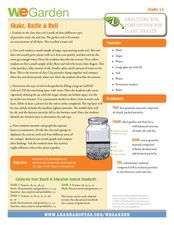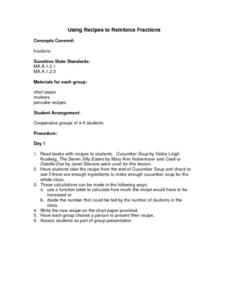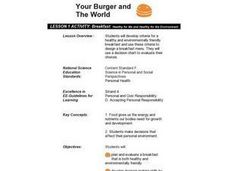Curated OER
Let's Cook
Students practice converting measurements into metrics. In groups, they translate a recipe from English into German and convert all measurements into metrics for the recipe. They examine the difference between United States and metric...
Curated OER
Leaping Lemurs! How far can you jump?
Students watch a segment of the PBS video which show the lemurs' ability to jump. In pairs, students collect measurement data involving each other's length of a standard step, a standing broad jump, and a long jump. They record their...
Curated OER
Friendship Quilt
Third graders name different kinds of shapes and then discuss what they know about them an what they would like to learn using a K-W-L chart whole group. They listen to the book, THE GREEDY TRIANGLE and then retell it to the class. They...
Curated OER
Celsius or Fahrenheit?
Second graders create a thermometer. In this Celsius or Fahrenheit lesson, 2nd graders create an individual thermometer to use for measuring the temperature. Students convert the outside temperature.
Curated OER
Squares and Cubes
Middle schoolers recognize, analyze, and use square color tiles and interlocking cubes to discover patterns in perimeter, area, and volume. They will then chart and graph their results.
Curated OER
Bar and Histograms (What Would You Use: Part 1)
Young scholars practice creating bar graphs using a given set of data. Using the same data, they create a group frequency chart and histograms. They must decide the best graph for the given set of data. They share their graphs with...
Curated OER
Interdisciplinary Task: Weather
Students design a chart to use to record the weather for five days. They then build an anemometer to record wind speed and discover why they are used for this purpose.
Curated OER
Common/Proper Nouns
Students sort word card into two categories (common and proper nouns). They copy the class charts. Students create a table in Word including the headings, common noun and proper noun. They put the correct words onto their chart and add a...
Curated OER
Altering a Plant Environment
Students investigate what a controlled group is by creating an experiment. In this plant growth lesson, students identify the different parts of a plant and discuss what is needed for a plant to be successfully grown. Students grow a...
Curated OER
Solar System Bead Distance Activity
Middle schoolers create a scaled solar system model using colorful beads. In this space science instructional activity, students convert AU units into metric measurements. They arrange the planets according to their distances from the sun.
Curated OER
Temperature School
Pupils observ the cooling and warming of room temperature, hot, and ice cold cans of water by measuring the change in temperature over time. They then attempt to develop explanations for the observations made and apply their findings to...
Curated OER
French Fry Run
Student explore estimation and measurement. In this measurement lesson, 2nd graders measure french fries, graph their data, and determine the size of french fries that is the best value. Students practice how to add prices and calculate ...
Curated OER
What's the Weather?
Second graders make daily weather observations, record them with appropriate stickers on a chart, and then summarize them at the end of the week in the form of a bar graph.
Curated OER
Can you Find the Expression
Students collect data from measurements and weights for this experiment. In this algebra lesson, students analyze graphs they create form their data to find the expression representing the data. They label which graph provided the best...
Curated OER
Clean Water vs. Dirty Water
Students study the importance of clean water to the survival of organisms and what activiities and material pollute water. They measure the temperature of water samples and create a class graph.
Curated OER
Using a Thermometer
First graders use their senses to formulate questions and make predictions to determine what is in the "Wonder Bag". They hold pieces of ice and examine while listing descriptors on a chart and then take their own temperature using an...
Curated OER
Can You Canula?
Students calculate the circumference of a circle. In this geometry lesson, students measure the diameter of a circle using micrometers or calipers. They investigate the relationship of the diameter to that of the value of Pi.
Curated OER
Shake, Rattle & Roll
Students examine soil. For this science lesson, students examine the layers of soil. Students collect soil from various locations and separate the layers. Students record and chart their findings.
Curated OER
Marvelous Marbles
Students predict the change in water volume when adding marbles to a graduated cylinder. In this Chemistry lesson plan, students will need to make accurate water measurements to determine the fluid displaced by the marbles. The students...
Curated OER
Using Recipes To Reinforce Fractions
Students calculate fractions used in various food recipes in this Math lesson with real world applications. The lesson is geared towards upper elementary students but can be adapted for various levels of learners. State math standards...
Curated OER
Breakfast: Healthy for Me and Healthy for the Environment
Students develop criteria for a healthy and environmentally friendly breakfast and use these criteria to design a breakfast menu. They use a decision chart to evaluate their choices which is imbedded in this plan.
Curated OER
One Square Meter
Learners explore the concept of a quadrat study. Students select and investigate a site and conduct a quadrat survey. They take measurements, observe the area and analyze their findings.
Curated OER
Animals at the Zoo
Students identify a variety of animals that can be found at the zoo and select one to conduct research on. In pairs they conduct Internet research, complete a graphic organizer chart, and create a two slide PowerPoint presentation.
Curated OER
Graphing Regions: Lesson 2
Students identify and analyze geographical locations of inventors. They each identify where their inventor is from on a U.S. map, discuss geographic patterns, and create a t-chart and graph using the Graph Club 2.0 Software.





